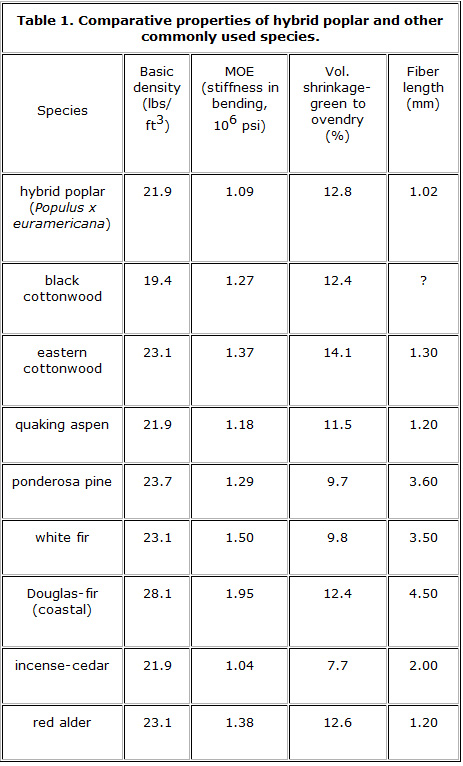Can hybrid poplar (a.k.a. hybrid cottonwoods) be used for products other than pulp and paper? The answer to this question depends on a number of things including the mechanical and physical properties of the wood. This information has not been readily available because most of the research on hybrid poplar has been conducted by pulp and paper companies and has been proprietary. Some publicly available information is being created, however, by a research group at Laval University in Quebec.
The Canadian researchers have examined the variability in fiber length, strength properties, density, and shrinkage characteristics of 10 different clones of Populus x euramericana, a hybrid of eastern cottonwood (Populus deltoides) and European black poplar (Populus nigra). We have experimented with hybrids of the same 2 poplar species in Klamath County (clone number OP-367) and in fact, found them to have the best growth rate and survivability of the 8 clones tested in the Klamath Basin.
Table 1 below summarizes the researchers findings and compares hybrid poplar to other commonly used species. Please note: The researchers found significant differences between the 10 clones tested. The table shows the average values for the 10 Populus x euramericana clones tested.

The strength properties of the hybrids studied in this research are lower than for other commercially used poplars such as eastern cottonwood and aspen. The MOE (stiffness in bending) values for these hybrids are more similar to western cedars such as incense-cedar or western redcedar than to other poplar species, pine, or fir. The properties of the hybrids tended to increase with age of the tree, therefore the wood of older trees may compare more favorably to that of commercially used poplars.
It is often expected that wood density will decrease as growth rate increases. Since strength properties for wood are so closely tied to density, fast-grown plantation species are often expected to produce wood of inferior strength properties. This has been shown to be the case for hybrid poplar, however the reductions in density and strength properties are slight.
Volumetric shrinkage for the hybrids tested is comparable to commercially used poplar species. The researchers noted, however, that the tangential shrinkage (across the grain shrinkage in width of a flatsawn piece) was higher than other poplar species. This type of shrinkage causes cupping in wide, flatsawn pieces.
Somewhat surprisingly, longitudinal shrinkage values for the hybrids were quite low, less than 0.5% from green to ovendry. As the trees tested were all 9 years old, it would be expected that the wood would be entirely juvenile wood, a type of wood known for excessive longitudinal shrinkage- up to 10 times as much as the "older" wood in the tree. This is good news for manufacturers interested in producing solid-sawn products from hybrid poplar as excessive longitudinal shrinkage leads to warping and splitting.
The hybrids studied in this research have fairly short fibers. Paper and composite product (for example, hardboard and medium density fiberboard) manufacturers are concerned with fiber length because of its positive influence on strength properties of the finished product. In the hybrids studied, fiber length was primarily influenced by age of the tree. Fiber length increased from the pith until about the eighth year and then leveled off. Fiber length also increased from the base of the tree upward and leveled off at mid-height.
The Canadian research provides evidence that foresters and the forest industry can select clones for the desired wood properties. The Populus x euramericana hybrids tested in Canada are similar to other commercially used poplars with the exception of lower strength properties and shorter fiber lengths. The most definitive information on the suitability of hybrid poplar for wood products will come from product trials.
For More Information:
Beaudoin, M., R.E. Hernandez, A. Koubaa, and J. Poliquin. 1992. Interclonal, intraclonal and within-tree variation in wood density of poplar hybrid clones. Wood and Fiber Science 24(2):147-153.
Koubaa, A., R.E. Hernandez, M. Beaudoin, and J. Poliquin. 1998. Interclonal, intraclonal and within-tree variation in fiber length of poplar hybrid clones. Wood and Fiber Science 30(1):40-47.
Hernandez, R.E., A. Koubaa, M. Beaudoin, and Y. Fortin. 1998. Selected mechanical properties of fast-growing poplar hybrid clones. Wood and Fiber Science 30(2):138-147.
Koubaa, A., R.E. Hernandez, and M. Beaudoin. 1998. Shrinkage of fast-growing hybrid poplar clones. Forest Products Journal 48(4):82-87.
DeBell, J.D. B.L. Gartner, and D.S. DeBell. 1998. Fiber length in young hybrid populus stems grown at extremely different rates. Canadian Journal of Forest Research 28(4):603-608."
